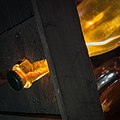Yeast: Difference between revisions
No edit summary |
CSV import |
||
| Line 70: | Line 70: | ||
[[Category:Medicinal fungi]] | [[Category:Medicinal fungi]] | ||
[[Category:Fungus common names]] | [[Category:Fungus common names]] | ||
<gallery> | |||
File:S cerevisiae under DIC microscopy.jpg|Yeast | |||
File:Simple diagram of yeast cell (en).svg|Yeast | |||
File:CC-BY icon.svg|Yeast | |||
File:Yeast lifecycle.svg|Yeast | |||
File:NM.0019545 Jästkrans.jpg|Yeast | |||
File:2009-03-21 Beer brewing bubbles.jpg|Yeast | |||
File:Schramsberg Vineyards, July 2019-7609.jpg|Yeast | |||
File:Compressed fresh yeast - 1.jpg|Yeast | |||
File:Dry yeast.jpg|Yeast | |||
File:Kombucha jar.jpg|Yeast | |||
File:Kombuchacultsm.jpg|Yeast | |||
File:Marmite.jpg|Yeast | |||
</gallery> | |||
Latest revision as of 01:07, 20 February 2025
Yeast (yeest) is a type of microorganism that is found almost everywhere, including inside the body. They are unicellular growth form of fungi. These cells can appear spherical to ellipsoidal. Yeast reproduce by budding. When buds do not separate, they can form long chains of yeast cells, which are called pseudohyphae. Yeast reproduce at a slower rate than bacteria.

Symbiosis[edit]
Small amounts of a certain type of yeast normally live on the skin and in some parts of the body, such as the mouth, throat, and vagina in a symbiotic relationship. Yeast are a type of fungus. Yeast is a type of single-celled fungus that is used in baking, brewing, and winemaking. Yeast cells are small and can only be seen under a microscope. They are oval in shape and reproduce by budding. Yeast plays a critical role in fermentation, a process that converts sugars into alcohol and carbon dioxide.
Types of yeast[edit]
There are several different types of yeast that are used in various applications:
Baker's yeast[edit]
Baker's yeast is a type of yeast that is used in baking bread and other baked goods. It is typically sold in small, dehydrated granules or compressed cakes. Baker's yeast is activated by warm water and sugar, which causes the yeast to start fermenting and producing carbon dioxide gas.
Brewer's yeast[edit]
Brewer's yeast is a type of yeast that is used in the brewing of beer and other fermented beverages. It is available in both liquid and dried forms and is used to convert sugar into alcohol during the brewing process.
Nutritional yeast[edit]
Nutritional yeast is a type of yeast that is grown specifically for use as a food additive. It is often used as a vegan or vegetarian substitute for cheese due to its savory, umami flavor. Nutritional yeast is also a good source of protein, vitamins, and minerals.
Uses[edit]
Yeast is primarily used in the production of fermented foods and beverages such as bread, beer, wine, and cheese. In bread baking, yeast helps the dough to rise by converting the sugars in the flour into carbon dioxide gas. This gas gets trapped in the dough, causing it to expand and become light and fluffy when baked.
In beer and winemaking, yeast is used to ferment the sugars in the liquid, producing alcohol and carbon dioxide gas. The type of yeast used can have a significant impact on the flavor and character of the final product.
Yeast is also used as a nutritional supplement due to its high content of protein, vitamins, and minerals.
Health benefits[edit]
Yeast has several potential health benefits, including:
- Rich source of B vitamins: Yeast is a good source of B vitamins, which are essential for maintaining good health.
- May boost immune function: Some studies suggest that the beta-glucans found in yeast may help to boost the immune system.
- May help to lower cholesterol: Some studies have found that consuming yeast may help to lower levels of LDL cholesterol, also known as "bad" cholesterol.
Risks[edit]
While yeast is generally considered safe for most people, some individuals may be allergic or sensitive to it. Symptoms of a yeast allergy may include hives, itching, and difficulty breathing. In rare cases, a severe allergic reaction called anaphylaxis may occur, which can be life-threatening.
Additionally, individuals with certain medical conditions such as Crohn's disease or celiac disease may need to avoid consuming yeast.
Yeast infections[edit]
Infections caused by candida species are commonly referred to as yeast infections.
External links[edit]
| This article is a stub. You can help WikiMD by registering to expand it. |
| Microbiology: Fungus | ||||||||
|---|---|---|---|---|---|---|---|---|
|
| Bread | ||||||||||
|---|---|---|---|---|---|---|---|---|---|---|
|
-
Yeast
-
Yeast
-
Yeast
-
Yeast
-
Yeast
-
Yeast
-
Yeast
-
Yeast
-
Yeast
-
Yeast
-
Yeast
-
Yeast










